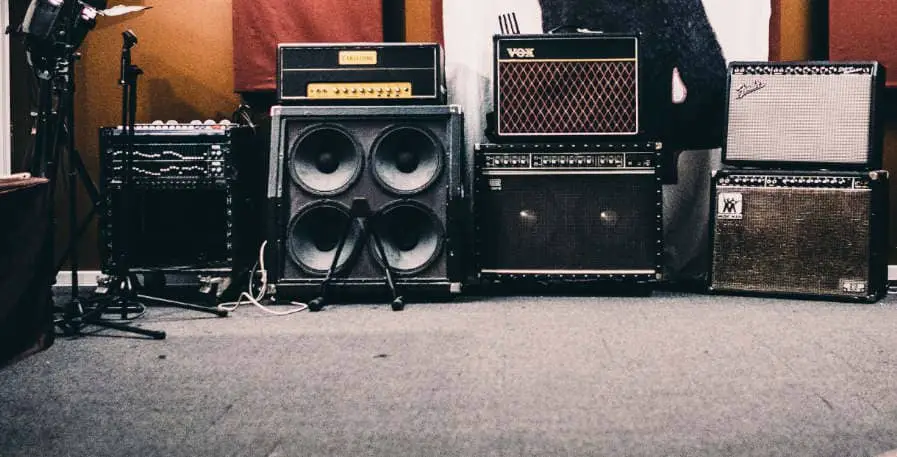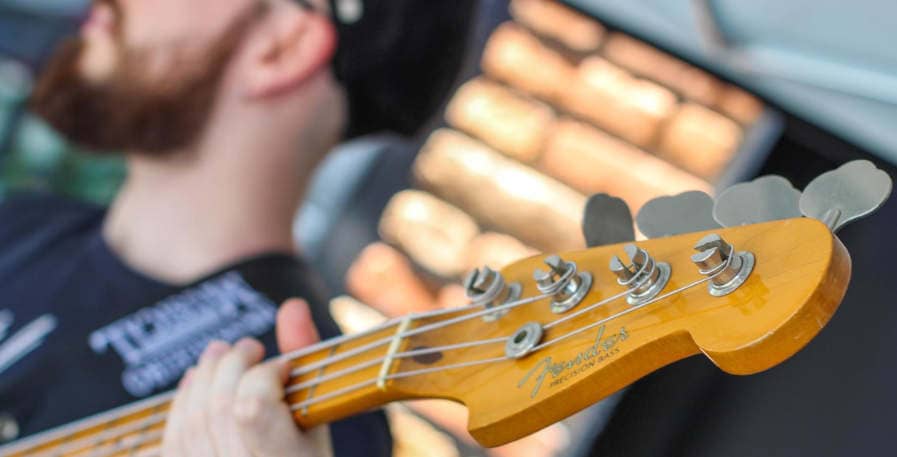Tuning bass guitars down is a common practice. Sometimes this is done to better fit the vocal range of the singer or to transpose a song. Most commonly though, it`s done by rock and metal bands to sound heavier. So if a lower tuning can result in a heavier sound, what is the lowest you can tune a bass?
A bass guitar can be tuned an octave below E standard tuning before the lowest pitch becomes indistinguishable to the human ear. Bass guitars can be tuned below this point, and some metal bands have tuned their basses as low as double drop A, which makes its lowest pitch an A-1.
A-1 is more than an octave deeper than the standard tuning of a 5-string bass. But if basses can be tuned this low, what stops us from going even deeper?
Below, I’ll show you why tuning this low already poses some challenges, and why tuning even deeper is possible, but difficult. I`ll also showcase some bands and bassists that have used the lowest known bass tunings.
This way, you`ll learn why most bands don`t tune to double drop A, and why we are yet to find what the lowest possible bass tuning actually is.
How low can a bass guitar go?
One way to look at what the lowest possible bass tuning is concerns at what point low pitches become indistinguishable to the human ear.
In general, humans can hear pitches as low as 20 Hz. Frequencies below 20 Hz are called infrasound and are so deep that most people can`t discern the difference in notes in this range under regular circumstances.
The low E on a 4-string bass in standard tuning is 41.2 Hz. The low B on a 5-string is 30.9 Hz. Thus, the full range of the bass guitar is discernable in standard tunings.
It is when we tune down below Drop G that this starts to become an issue. The limits start to get pushed at Drop F, and at Drop D# we have entered the infrasound frequency range.
| Pitch | Frequency |
| F0 | 21.83 Hz |
| E0 | 20.60 Hz |
| D#0 | 19.45 Hz |
| D0 | 18.35 Hz |
From this point of view, Drop E and E standard an octave below standard tuning, are the lowest bass tunings possible.
However, while an open D string on a bass tuned to double drop D doesn`t have a distinguishable pitch to us, basses have still been tuned this low. This is because, in a band the open D string will still fill a harmonic role and feel like a root note, despite being in the infrasound frequency range.
As a result, some bassists have tuned to tunings such as double drop D, and even double drop A# and double drop A. Let`s proceed by taking a listen to what this sounds like.

What band uses the lowest tuning?
While Drop A is considered a deep tuning, some bassists have tuned as far as an octave down from it.
Some of the bands that have used unconventionally low bass tunings include the following:
| Band | The lowest bass tuning used | Pitch below E Standard | Songs that use this tuning |
| Glass Cloud | Drop F | 5 whole steps (Minor seventh interval) | She Is Well and Nothing Can Be Ill |
| Humanity’s Last Breath | Drop E | An octave | Abysmal Mouth |
| Loathe | E Standard – Octave lower | An octave | East Of Eden |
| Black Tongue | Double Drop D | An octave and a whole-step | H.C.H.C |
| Meshuggah | Double Drop A# | An octave and a tritone | Spasm |
| FRACTALIZE | Double Drop A | An octave and a perfect fifth | Suneater |
The most well-known among these bands is Meshuggah. While they have played in a multitude of tunings, the lowest they have gone is double drop A#.
This makes the thickest open string of the bass an A#-1. This pitch has a frequency of 14.57 Hz and is well within the infrasound range which makes pitches hard to distinguish. Despite this, the bass is still able to fill a harmonic and rhythmic role in the context of the band on their song “Spasm”:
Another notable artist is FRACTIZLIE, who has tuned a half-step deeper than this to Double Drop A. This means the open A rings out at a frequency of 13.75 Hz.
While it can be hard to discern the difference in tunings when they get this low, this does make “Suneater” the lowest-tuned song out there to the best of my knowledge:
The limits of bass guitars
In my guide to drop C#, I mention that this is the point where you will require thicker strings and a setup to properly play the bass. Now, if this is needed when tuning down 1 and a half steps, imagine what happens when tuning down 9 whole steps.
The answer is that you need excessively thick strings and a thorough setup that ensures that your bass won`t become permanently damaged.
For drop E, it is common to use a string with a gauge of .210 or .200 for the low E0. A string of this size will put an immense amount of tension on the neck of a bass. Low-quality basses will struggle to deal with this, and no bass will be able to handle this level of tension without being properly set up for it.
There is thus a clear physical limitation on how low a bass can be tuned due to string thickness, and the tension they will put on the neck. While it is unknown where this limit lies, it is clearly possible to tune basses below double drop A before it becomes physically impossible to go deeper.

The limits of amplifiers
It is a best practice to not play a bass through a guitar amplifier as they are not designed to handle the lower frequencies. When tuning a bass as low as Double Drop A, the same issue starts to arise, as not all bass amplifiers will be able to handle these frequencies either.
Thus, the limits of tuning down a bass are not just based on what we can hear. Amplifiers will all have their own limits for how low frequencies they can handle without being damaged.
Another concern is also how low they can go while retaining a pleasant sound. An amplifier might be able to amplify a low bass note, but not with a flat frequency response. Simply put, this means the sound of the bass will be altered, and rarely for the better.
There are basses and amps specifically designed to handle deep tunings. However, double drop A is such a niche tuning that no manufacturer is making amps to specifically fit it. Thus, amplification will play a role in how low we can realistically expect to tune a bass guitar while retaining a pleasant live sound.
Conclusion
The lowest bass tuning that has been used is double drop A, which makes the lowest pitch an A-1.
This tuning puts an immense amount of tension on the neck of the bass, won`t sound good through many amplifiers, and requires excessively thick bass strings. Bands that have tuned this low or close to it, have however made it sound extremely good.
Basses can most certainly be tuned lower than double drop A. There are however multiple reasons it`s hard to say how much deeper it is possible to go.
One factor is the opinion of the bassist and the listener. When do strings become too thick to be playable, and when does the music become so deep that tuning down becomes redundant and unlistenable? The answer will vary from person to person, and thus we are unlikely to find an agreed-upon answer to it.
The last reason the answer is undetermined is the limitations of basses and amplifiers. Bass guitars and bass gear are generally not designed to handle double drop A or any tuning below it. Thus, it is hard to say how far basses and amps can be pushed to handle low tunings, as they are rarely if ever made specifically for this purpose.
Due to few bands tuning this low, it is still hard to say what types of untapped potential lies in the lowest possible bass tuning. But as there will always be a metal band trying to sound heavier than the next, I am sure the boundaries of how low basses can be tuned are only going to be pushed further.
Another issue with tuning basses as low as possible is that the bass becomes harder to hear in a mix. This can be unfortunate, as metal bassists already often struggle to be heard on tracks. To learn more about why check out my article on why it`s hard to hear the bass in metal songs.

